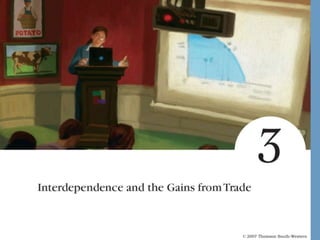
03_4E - Interdependence and the Gains From Trade - Part 1 of 2.ppt
- 1. © 2007 Thomson South-Western
- 2. © 2007 Thomson South-Western Consider your typical day: • You wake up to an alarm clock made in Korea. • You pour yourself orange juice made from Florida oranges and coffee from beans grown in Brazil. • You put on some clothes made of cotton grown in Georgia and sewn in factories in Thailand. • You watch the morning news broadcast from New York on your TV made in Japan. • You drive to class in a car made of parts manufactured in a half-dozen different countries. . . . and you haven’t been up for more than two hours yet!
- 3. © 2007 Thomson South-Western Interdependence and the Gains from Trade Remember, economics is the study of how societies produce and distribute goods in an attempt to satisfy the wants and needs of their members.
- 4. © 2007 Thomson South-Western Interdependence and the Gains from Trade • How do we satisfy our wants and needs in a global economy? – We can be economically self-sufficient. – We can specialize and trade with others, leading to economic interdependence.
- 5. © 2007 Thomson South-Western Interdependence and the Gains from Trade • Individuals and nations rely on specialized production and exchange as a way to address problems caused by scarcity. • But this gives rise to two questions: – Why is interdependence the norm? – What determines production and trade?
- 6. © 2007 Thomson South-Western Interdependence and the Gains from Trade • Why is interdependence the norm? – Interdependence occurs because people are better off when they specialize and trade with others. • What determines the pattern of production and trade? – Patterns of production and trade are based upon differences in opportunity costs.
- 7. © 2007 Thomson South-Western Imagine an economic system with only two goods, potatoes and meat and only two people, a potato farmer and a cattle rancher • What should each person produce? • Why should these people trade? A PARABLE FOR THE MODERN ECONOMY
- 8. © 2007 Thomson South-Western
- 9. © 2007 Thomson South-Western Production Possibilities • Suppose the farmer and rancher decide not to engage in trade: • Each consumes only what he or she can produce alone. • The production possibilities frontier is also the consumption possibilities frontier. • Without trade, economic gains are diminished.
- 10. © 2007 Thomson South-Western Figure 1 The Production Possibilities Frontier Potatoes (ounces) 4 16 8 32 A 0 Meat (ounces) (a) The Farmer ’s Production Possibilities Frontier If there is no trade, the farmer chooses this production and consumption. Copyright©2003 Southwestern/Thomson Learning
- 11. © 2007 Thomson South-Western Figure 1 The Production Possibilities Curve Copyright©2003 Southwestern/Thomson Learning Potatoes (ounces) 12 24 B 0 Meat (ounces) (b) The Rancher ’s Production Possibilities Frontier 48 24 If there is no trade, the rancher chooses this production and consumption.
- 12. © 2007 Thomson South-Western Production and Consumption Without Trade
- 13. © 2007 Thomson South-Western The farmer should produce potatoes. The rancher should produce meat. Specialization and Trade • Suppose instead the farmer and the rancher decide to specialize and trade… • Both would be better off if they specialize in producing the product they are more suited to produce, and then trade with each other.
- 14. © 2007 Thomson South-Western Figure 2 How Trade Expands the Set of Consumption Opportunities Copyright©2003 Southwestern/Thomson Learning Potatoes (ounces) 4 16 5 17 8 32 A A* 0 Meat (ounces) (a) The Farmer’s Production and Consumption Farmer's production and consumption without trade Farmer's consumption with trade Farmer's production with trade
- 15. © 2007 Thomson South-Western Figure 2 How Trade Expands the Set of Consumption Opportunities Copyright © 2004 South-Western Potatoes (ounces) 12 24 13 27 B 0 Meat (ounces) (b) The Rancher’s Production and Consumption 48 24 12 18 B* Rancher's consumption with trade Rancher's production with trade Rancher's production and consumption without trade
- 16. © 2007 Thomson South-Western COMPARATIVE ADVANTAGE • Differences in the costs of production determine the following: – Who should produce what? – How much should be traded for each product?